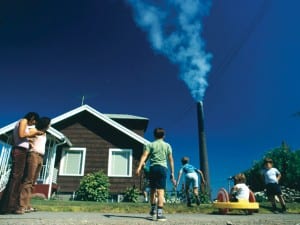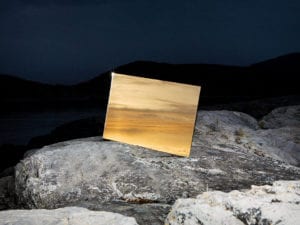Andrea Grützner’s (b. 1984) compositions deal with the emotional and visual perception of spaces. These images seek both familiar and disconnected subject matters, and ask questions about the memory of places and our orientation of designed interiors. Grützner finds and creates photographs that oscillate between image-making and painting, exploring ideas of documentary, surrealism, abstraction and visual irritation. Eclectic interiors draw links to retro computer games and traditional guest houses from the former German Democractic Republic, casting a diverse history of human behaviour against an intriguing interplay of colour and form. Bold lines and shadows ruminate in these compelling labyrinthine images, transforming the everyday and altering interior landscapes with gels, flash lights and motif-mapping. Grützner won the 2017 ING Unseen Talent Award, with the Hive series, developing work alongside Nadav Kander, and has exhibited with Foam Amsterdam, Photo London and Paris Photo, amongst many other fairs and galleries.
A: The term “emotional architecture,” was attributed to Mexican architect Luis Barragán (1902-1988) and sculptor-painter Mathias Goéritz (1915-1990), who, together, published a manifesto in search of spiritually uplifting buildings that subverted the minimal, “sterility” of modernism. The document was built on the premise that spaces engender a tangible psychological response in individuals. Though your photographs dwell within architectural structures, how do you feel that they are, inherently, “anti-architectural” or resist this definition?AG: I often depict space in a fragmentary way, focusing on details and certain elements instead of showing the ideal (descriptive) perspective of a building or room to give a desired spatial idea. My gaze cuts through the space – that’s where the description of “anti-architectural” comes from. “Emotive” could also be added to the definition of my practice, as, ultimately, I’m translating my subjective perception and sensation of the space onto the production of images.
A: Houses and interior domestic spaces have provided a creative wellspring for artists over the years, with memories embedded in rooms and histories told through the walls. What might we find in the “nooks” and “crannies” of your images, in the histories or stories exist there? How important is it that these stories remain invisible, with the structures devoid of their inhabitants?
AG: Individual stories, memories and emotions are not important for understanding my work or its effects on the viewer. The images speak more about my personal encounter with that specific space, which seems to be full of pro- jections and secrets. I’m trying to avoid the more obvious details of houses or structures, as they would immediately spark a more stereotypical imagination and narrative. It is more about slowly discovering familiar elements within the abstract image construction, which might recall own memories of the viewer. My work is, essentially, quite open-ended.
A: Your images share many similar colour palettes of Barragán, with blush pinks, bold oranges and luminous yellows taking centre stage, amongst a variety of patterns, shapes, slats and oblongs. What interests you about the colour palettes of interior structures?
AG: Colour is intriguing, it can be challenging and seducing, abstract and so real. It triggers certain memories. The original interior of the Erbgericht has nostalgic palettes of cream-brownish hues and elements in pastel tones. The vivid glowing shadows stems from experimentation with colourful gels in front of flashlights. So I’m adding my own colour palette to the building. My colours are kind of coexisting with(in) the house. For me, they work like a placeholder for memories and emotions from all people who have been attached to, or visited, that building. The luminous shades are pulling the beholder into the image-space and leave them to their own imagination and interpretation. In general, I try to exaggerate artificial characters, playfulness and an overarching sense of eeriness. This is also the case in Hive, where I used the poppy bold colours of the given educational design.
A: There’s also an MC Escher-like quality to your compositions. Staircases disappear into hovering cabinets and reflections merge spaces into a kind of labyrinth. Why is removal, distortion or complication important?
AG: I often strive for tilting moments and reversing perspectives. It’s a visual game with the perception of space, time and surface structures – an optical charade. I regularly ask myself: how can I make the familiar and obvious strange, and vice versa, the strange curiously familiar? All these processes are playfully challenging our looking habits and slowing down the way of deciphering. They are also speaking, in a general sense, about another possible reading of systems.
A: In Erbgericht, you utilise a bright flash to achieve a sense of collage and transformation – creating pro- nounced lines, shadows and artificial planes, with stark contrasts playing out across the compositions. Can you expand on the technical aspect of your work?
AG: I set up flashlights, scattered throughout spaces. These are all connected up and fired in the same moment. I then scan the negatives and just do smaller adjustments in brightness and colour hues. To set up the lighting can take between four and eight hours, depending on the number of variations that I’m doing. Additionally, around one to three days go into pre-studies and light experiments for each motif. My sketchbook is essential here. Sometimes, though, images won’t work at the end, and the process starts all over again.
A: You often respond intuitively to locations. The Hive series, for example, draws from retro computer games, shot in Melbourne’s RMIT University, filled with angular metals and maze-like spaces. In what capacity are you exaggerating a sense of “play” or development in the space – where individuals are required to “advance” from one level to the next, much like in education?
AG: The contemporary infrastructure at RMIT is already built towards being photographed – to be shared via social media platforms. It is strongly influenced by science fiction films, pop culture and “fun houses.” For me, these maze-like rooms work as a metaphor for orientation, “gamification” and alienation in our modern society – themes that proliferate and only continue to grow. I ask: how can we deal with the seduction and ambiguity of such spaces, which already have ideas of a global neoliberal society – like flexibility, mobility, mixing work and leisure time, networking – build into them? My attempt is to amplify the design through a roster of digital collage techniques, also to point towards the blending of virtuality and reality in these performative environments.
A: The das ECK series (The Corner) considers the framework of urban spaces, and the graphic nature of our en- vironments today. To what extent was this series a depar- ture – with less collage or double exposure?
AG: I was invited to Koblenz as a city photographer in 2015/2016, shortly after publishing my first 16 images of Erbgericht. For me, it was important to not copy-paste my style with the colourful lighting, but rather find a related way of seeing space and translating it into an image of some- thing new entirely. The mundane post-war architecture is very present in the city, so I decided to mainly focus on its elements, still with a fragmentary, surreal and graphic touch.
A: Works from the ongoing Erbgericht series are currently on show at Robert Morat Galerie, Berlin, a project which plays on the loose translation of inheritance. How does the title relate to the images, and where they were shot?
AG: My work Erbgericht (or “Guest house”) stems from a devotion to a traditional country inn located in a former GDR village, where I’m originally from. As an important cultural centre for the rural community, the Erbgericht managed to survive five political systems (the German Empire, the Weimar Republic, the Nazi era, the Communist era, and today’s reunified Germany.) The cultural history goes back to medieval ages, when these houses were the seat of the local judge, who also often got the rights to brew and slaughter. This position was passed on to the next generation. Even in Ger-many, almost nobody knows the etymology, but the words “Erb-” and “Gericht” are so familiar. It’s just their combination which makes it strange and unfamiliar. This is the reason why I kept the name of the building for my work. The Erbgericht is an intriguing collage of historical layers – patterns, materials, furniture, and my family still celebrates important events in its rooms. Yet, many memories of the village and its inhabitants, including those of my family, seem inaccessible to me. It’s a constant shift between being familiar and unfamiliar, with a lot of secrets. My photographs work like a translation of my relationship to my former homeland.
A: How do you choose your locations?
AG: Part of my motivation is certainly a preoccupation with my origins: an early childhood socialisation in the GDR and our move to the west after the fall of the Wall with still close contact to our relatives near Dresden. So, the Erbgericht is still a favourite place to work. I am currently also obsessed with a building block set for kids from GDR times, a project I’ve started working with a Bauhaus residency. I’m still trying to figure out my fascination with “built” things. Spaces and atmospheres can attract and repel me – and definitely trigger me. It’s incredible what influence architecture can have on people and what social roles it imbibes. Ideologies and power structures are conveyed through it, and spatial policies are contested with it. Architecture plays a fundamental role in cultural memory and the function of society in space.
A: What else do you have planned for 2021?
AG: Diving into the pictorial adventures I’ve sketched above.
Words: Kate Simpson
Erbgericht – Neue Räume, Robert Morat Galerie, Berlin, Until 31 July | robertmorat.de
Image Credits:
1. Andrea Grützner, Hive, Showcase, 2019, framed digital collage, 133 x 100 cm. Courtesy of the artist.
2. Andrea Grützner, Erbgericht, untitled 18, 2018, framed photograph, 149 x 100 cm (81 x 60 cm). Courtesy of the artist.
3. Andrea Grützner, Detail of Hive, The Lawn, 2019, framed digital collage, 60 x 45 cm. Courtesy of the artist.
4. Andrea Grützner, Detail of Erbgericht, untitled 19, framed photograph, 2018, 149 x 100 cm (81 x 60 cm). Courtesy of the artist.
5. Andrea Grützner, Hive, The Hive, 2019, framed digital collage, 60 x 45 cm. Courtesy of the artist.








